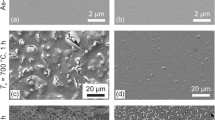34
Si23N43 (b3) and Ti35Si13N52 (c3), are synthesized by reactively sputtering a Ti5Si3 or a Ti3Si target, respectively. The silicon-lean film (c3) has a columnar structure closely resembling that of TiN. As a diffusion barrier between a shallow Si n+p junction diode and a Cu overlayer, this material is effective up to 700 °C for 30 min annealing in vacuum, a performance similar to that for TiN. The silicon-rich (b3) film contains nanocrystals of TiN, randomly oriented and embedded in an amorphous matrix. A film of (b3) maintains the stability of the same diode structure up to 850 °C for 30 min in vacuum. This film (b3) is clearly superior to TiN or to (c3). Similar experiments performed with Al instead of Cu overlayers highlight the importance of the thermodynamic stability of a barrier layer and demonstrate convincingly that for stable barriers the microstructure is a parameter that directly determines the barrier performance.
Similar content being viewed by others
Author information
Authors and Affiliations
Additional information
Received: 18 November 1996/Accepted: 22 January 1997
Rights and permissions
About this article
Cite this article
Sun, X., Kolawa, E., Im, S. et al. Effect of Si in reactively sputtered Ti-Si-N films on structure and diffusion barrier performance . Appl Phys A 65, 43–45 (1997). https://doi.org/10.1007/s003390050539
Issue Date:
DOI: https://doi.org/10.1007/s003390050539



